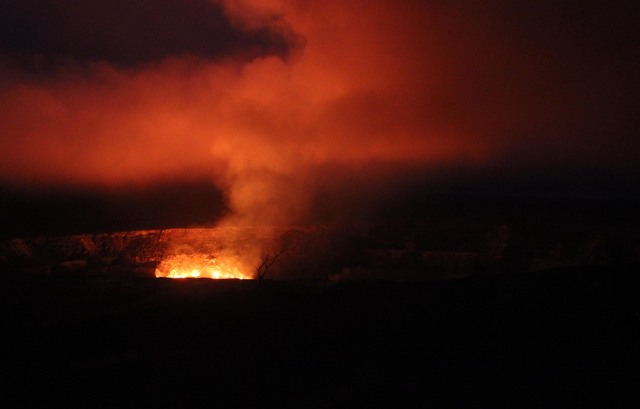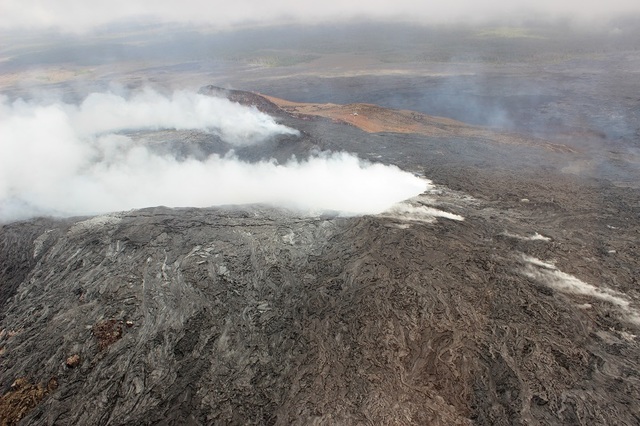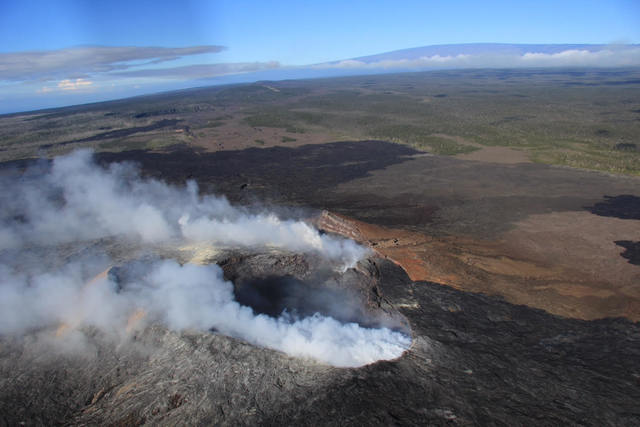Editor’s note: Over the next few weeks, West Hawaii Today will be taking a closer look at each of the volcanoes on and around Hawaii Island. This week is Kilauea Volcano.
Perhaps Hawaii Island’s most infamous volcano, and indeed, one of the world’s most active volcanoes, is Kilauea. Its Puu Oo Cone has been continuously erupting since 1983, sending enough lava streaming into the sea to add more than 500 acres of new land to the island.
Kilauea made national news last year when a lava flow from a new eruption site off Puu Oo sent lava down its northeastern slopes, through area forests and toward the community of Pahoa before its leading edge stopped suddenly in March.
“The overall change or process that led to the flow’s demise, was a series of large, persistent and nearly continuous breakouts in the upper part of the lava tube,” said Steve Brantley, deputy scientist in charge of the U.S. Geological Survey’s Hawaiian Volcano Observatory, the group that monitors volcano’s activity. “One of the largest breakouts in mid-November 2014 temporarily cut off the supply of lava to the tube, which caused the June 27 flow in Pahoa to become inactive within days. … The breakouts occurred when there was an increase in eruptive discharge, and at some point the tube couldn’t accommodate it all. This diverted lava out of the tube onto the surface — not just some, but most of the lava broke out — and that essentially led to the starving of the tube.”
Unfortunately, should another community-threatening flow occur, “We wouldn’t be able to just take a hammer and poke a hole in the side,” said Brantley. “The whole issue of lava diversion is really very complex. Lava tubes are sometimes several meters below ground, and even on the surface can be several meters thick. The Italians once tried to breach a lava flow levee on Etna by putting explosives on it, but it’s not really predictable how successful you are going to be.”
Though lava no longer threatens communities — and Brantley refers to the last few months as “the relative quiet of Kilauea” — the volcano is still erupting in two separate places: at the summit within Halemaumau Crater and at the Puu Oo cone within the volcano’s East Rift Zone
The eruption at the summit began with a small explosive eruption within Halemaumau Crater in 2008, where a bubbling lava lake has been visible almost continuously since early 2010. Lava rose up, briefly spilling onto the crater floor in late April and early May of this year, much to the excitement of Hawaii Volcanoes National Park visitors, who could see the lava from the Jaggar Museum Overlook. The most recent excitement at the Puu Oo cone happened in August when lava erupted from an existing vent on the crater floor — it closed several days later. And, lava flows, ongoing since last year’s June 27 Puu Oo cone eruption, continue to creep into unpopulated forested areas within five miles of the vent and at least six miles from populated areas downslope.
“At the moment,” he said, “we are continuing to monitor Kilauea and Mauna Loa as we have in the past few years. We’re maintaining the monitoring network and upgrading instruments so that we are ready to characterize the activity well when things start to change.”
Maintaining and upgrading monitoring equipment is the only thing scientists can do, because planning or even preparing for the next eruption is futile. “One thing that is challenging with these very large shield volcanoes in Hawaii is that each has multiple locations where eruptions occur,” said Brantley. Any proactive measures “would predicate on knowing where the next eruption is going to occur, knowing where the lava is going to flow and for how long, and also trying to anticipate the discharge rate.”
Not all of Kilauea’s eruptions are slow and steady lava flows. In fact, according to the USGS, Kilauea has had more recent violent eruptions — forcefully ejecting magma, ash and debris — than the island’s other volcanoes. In the last 1,500 years, the volcano has sent ash up into the jetstream on at least six occasions. Brantley says Kilauea’s recent proclivity for violent eruptions could be because its magma reservoir is closer to the groundwater table than that of other volcanoes — when water touches magma, it can violently flash to steam.
And, Kilauea’s show isn’t nearly over.
“The Pacific Ocean plate is moving over the hotspot at about eight to 10 centimeters per year. Like Oahu and Kauai and islands further down the chain, Hawaii Island will at some point be hundreds of miles away from the current hotspot,” Brantley said. “Our understanding of persistent volcanism is that as long as these volcanoes are connected to the hotspot, they will keep being supplied with magma and continue to erupt. Detaching doesn’t happen in just a few centuries of time. It takes hundreds of thousands of years.”











